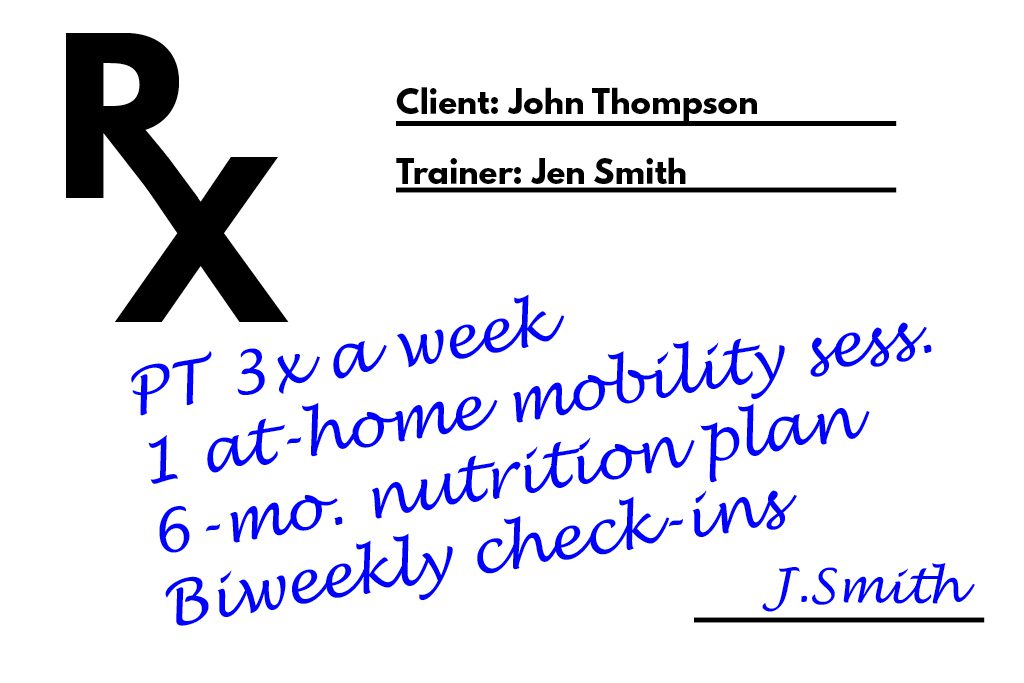To succeed in the new era of gym ownership, you have to go deeper.
Each client carries more value than ever before. A free trial class, three options based on attendance and a link to scoring software? That stopped working in 2016 (and it barely worked then).
Now, every client must maintain a 1:1 connection to you, start the client journey with a consultation and receive a prescription that’s regularly updated. In Part 1, I told you how to use a consultative process, like a No Sweat Intro or a motivational interview. Today, I’m going to tell you how to design a client’s program based on their primary need and then deliver it with excellence.
In Part 3, we’re going to talk about the most important (and almost-always overlooked) part: refining a client’s journey with you.
A Program =\= Programming
As a fitness coach, you’re not just selling exercise. If you’re a CrossFit affiliate, remember: Nutrition is the base of the fitness pyramid. Metabolic conditioning and other types of exercise are added to that base.
But how you do you, as a coach, deliver the client’s nutrition and exercise prescription?
First, start with objective measurement. After determining a client’s real “why,” you must find Point A. Measure what the client cares about. If they want weight loss, measure their weight. If they want fat loss, measure their fat. If they want to gain flexibility, measure their flexibility. If they want to gain strength, measure their strength.
You already know their Point B, thanks to your intake interview.
Next, good fitness coaches map the path backward from Point B to Point A. Like this:
After they’ve mapped the process, great coaches prescribe the fastest path to their clients. Like this:
“Well, Alice, here are the steps you’ll need to take to reach your goal. To get there quickly, you’ll need to exercise five times per week and follow a clear nutrition plan. How does that sound?”
Next, great coaches tailor the delivery of their service to a client’s preferences. Like this:
“OK, Alice. Would you prefer to do your workouts here at the gym or at home on your own—or would you prefer a combination?”
Great coaches guide their clients by presenting one option at a time instead of overwhelming them with choices.
Next:
“OK, Alice. You prefer to work out with us at the gym. That’s fantastic. Would you prefer to do your workouts one-on-one with me or in a small group?”
Then great coaches overcome barriers, such as price objections or injuries. Like this:
“No problem, Alice. If you can’t afford to train 1:1 with me all the time, we can move you to our budget option of training in a group. We use the most effective group workout strategy on the planet. It’s called CrossFit—have you heard of that?
Or like this:
“No problem. If you can’t afford to move that quickly, we’ll take it a bit slower. With the budget you just gave me, I’d say we should train twice per week and really focus on that nutrition plan.”
Or like this:
“No problem. Your back is tight from work. We’ll take it a bit slower at first. With the limitation you just gave me, I’d say we should train three times per week and have one specific mobility session per week instead of four workouts.”
Then great coaches motivate clients by reminding them of their wins, showing them their progress and calling them when they don’t show up.
Along the way, they track progress, and adjust the plan—because no plan survives first contact with the enemy. And the enemies (Big Sugar, Netflix and cortisol) are pretty good at this game. So staff at Two-Brain gyms meet with their clients every quarter to adjust their plans.
But no one loses sight of the goal. The coach can’t afford to because the client never stops thinking about it. Clients don’t do your workouts for the sake of being good at your workouts; they do them because they want to achieve their real goal. And they’re willing to trade short-term pain to get there—if they trust their coach.
We call this The Prescriptive Model. Here’s an early podcast we did on the subject: Two-Brain Radio. But I walk through it step by step in my latest book, “Founder, Farmer, Tinker, Thief.”
Great coaches don’t sell group programming. Great coaches sell 1:1 relationships, sometimes delivered in a group.
What’s included in that solution? Refer to the cornerstones of your business: nutrition coaching, personal coaching, group coaching and online (habits) coaching. Here’s more on that topic: “Your Gym 2.0: The Four Cornerstones.”
Show the client your plan. Ask “how does this look?” and then prescribe the solution using your pricing binder.
The last step before you get started on programming: Book a review three months later. In Part 3, I’ll tell you how to review client progress, update prescriptions and keep clients around for the long haul.
Other Media in This Series
The New Client Journey: Motivational Interviewing
The New Client Journey: Reviewing Their Progress

